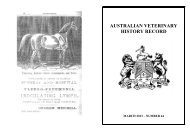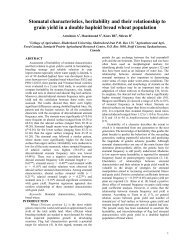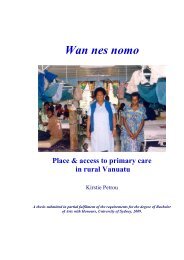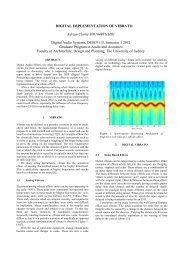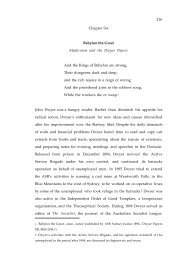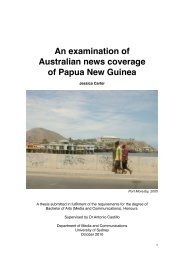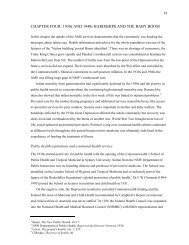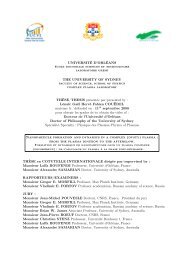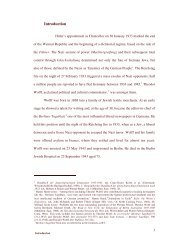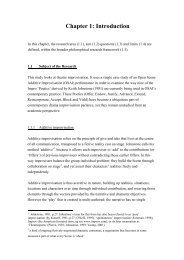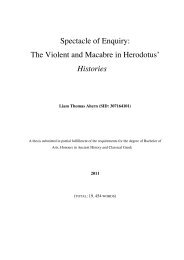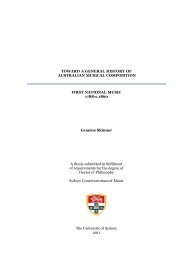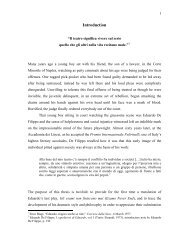Chapter 6: Tense, aspect and mood
Chapter 6: Tense, aspect and mood
Chapter 6: Tense, aspect and mood
Create successful ePaper yourself
Turn your PDF publications into a flip-book with our unique Google optimized e-Paper software.
nasal does not vary with an alveolar, whereas in subclass 1B(ii-b) both apicals are attested in the<br />
NP2. Table 6.5 presents the paradigms.<br />
Suffixes<br />
1B(ii-a): +wa-<br />
(e.g. -yu+wa- ‘follow’)<br />
1B(ii-b): -arrka- ‘pull’<br />
NP1 -Ø -yu+wa-Ø -arrkv-Ø<br />
NP2 -rna ~ -na -yu+wa-rna -arrkv-rna ~ -arrkv-na<br />
NP3 -ma (~ -ngvma) -yu+wa-ma ~ -yu+wa-ngvma -arrkv-ma ~ -arrka-ma<br />
P1 -Ø -yu+wa-Ø -arrka-Ø ~ -arrkv-Ø<br />
P2 -rnv -yu+wa-rnv -arrka-rnv<br />
REFL -jungwV- -yu+wa-jungwV- ?-arrka-jungwV-<br />
RECP -yi- -yu+wee-yi- ?-arrkee-yi-<br />
CAUS -ji- -yu+wa-ji- ?-arrka-ji-<br />
Table 6.5: Conjugation 1B(ii): -rna ~ -na, -rnv<br />
The forms marked with ‘?’ in this table are not attested but are extrapolated from other verbs in the<br />
same subclass. The retroflex nasal in the NP2 is not attested for all 1B(ii-a) verbs, but their NP2<br />
suffix is always preceded by [əә], which suggests the former presence of an retroflex (see <strong>Chapter</strong><br />
2). Verbs belonging to the two 1B(ii) subclasses include:<br />
(8) Class 1B(ii-a) (2 roots) Class 1B(ii-b) (7 roots)<br />
-ma- ‘light a fire’ -akbvrranga- ‘find’<br />
Thematic +wa- -yaka- ‘take away from’<br />
(e.g. -yu+wa- ‘follow’ +arrnga- ‘break, split, bend’<br />
-yarru+wa- ‘go past’ -arrka- ‘pull’<br />
-ngadhu+wa- ‘cry for’ -akuma- ‘put’<br />
-marra+wa- ‘w<strong>and</strong>er’ -lhvmakba- ‘look for turtle eggs’<br />
-bvrru+wa- ‘crawl’) -angka- ‘fetch’<br />
More complex stems composed of thematic +wa- can be found in <strong>Chapter</strong> 5, Table 5.9. The RECP<br />
form of -akbvrranga- ‘find’ varies between -akbvrrangee-yi- <strong>and</strong> -akbvrranga-nja-. In <strong>Chapter</strong> 9 I<br />
will argue that the latter aberrant form is a remnant of the proto-Gunwinyguan RECP form *-nyji-.<br />
6.3.2 Conjugation 2: -na, -ngv [JH class 8B (-ena, -ang); JW class -ena, -anga; VL class 2B<br />
(-ani, -anga)]<br />
This is another large conjugation, containing 31% of the 251 verb roots in Leeding’s corpus. It is<br />
characterised by the NP2 ending -na <strong>and</strong> the P2 ending -ngv. The stems in this class presumably<br />
end in /a/, but this vowel undergoes the most changes in comparison with the other conjugations.<br />
One important change is its realisation as [ɛ] in the NP2 forms. Two subclasses can be<br />
distinguished based on the quality of stem-final vowel when followed by a derivational suffix,<br />
which is fully predictable: in subclass 2A, this vowel is preceded by a peripheral consonant, <strong>and</strong><br />
208



